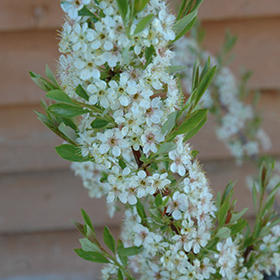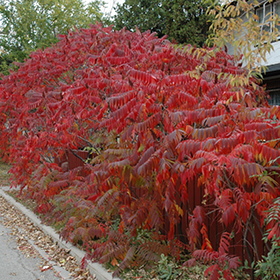Description
Growth & Care
| USDA Plant Hardiness Zone | 2b |
| Growth Rate | Average |
| Recommended Pruning Method | Late Winter Pruning |
| Fruit Tree Pollinator Requirement | Self-pollinated |
Foliage
| Foliage Type | Deciduous |
| Fall Color | Red |
| Plant Form | Spreading |
Flowers
| Flower Period | Spring |
| Flower Color | White |
| Flower Fragrance | High |
Additional Categories
| Additional Category | Cherry |
| Landscape Application | Massing, Rock, Garden, Groundcover, Naturalizing |
Details
Planting & Growing
Pawnee Buttes Western Sandcherry will grow to be about 18 inches tall at maturity, with a spread of 5 feet. It tends to fill out right to the ground and therefore doesn't necessarily require facer plants in front. It grows at a medium rate, and under ideal conditions can be expected to live for approximately 20 years. This is a self-pollinating variety, so it doesn't require a second plant nearby to set fruit.
This shrub should only be grown in full sunlight. It is very adaptable to both dry and moist growing conditions, but will not tolerate any standing water. It is considered to be drought-tolerant, and thus makes an ideal choice for a low-water garden or xeriscape application. It is not particular as to soil type or pH. It is highly tolerant of urban pollution and will even thrive in inner city environments. This is a selection of a native North American species.
Landscape Attributes
Pawnee Buttes Western Sandcherry is a multi-stemmed deciduous shrub with a ground-hugging habit of growth. Its relatively fine texture sets it apart from other landscape plants with less refined foliage.
This is a relatively low maintenance shrub, and is best pruned in late winter once the threat of extreme cold has passed. It is a good choice for attracting birds to your yard. It has no significant negative characteristics.
Pawnee Buttes Western Sandcherry is recommended for the following landscape applications:
Mass Planting, Rock/Alpine Gardens, General Garden Use, Groundcover, Naturalizing And Woodland Gardens
Ornamental Features
Pawnee Buttes Western Sandcherry is draped in stunning fragrant white flowers along the branches in mid spring before the leaves. It has grayish green deciduous foliage. The pointy leaves turn an outstanding burgundy in the fall. The fruits are showy deep purple drupes with black overtones, which are displayed in mid summer.
This plant is primarily grown as an ornamental, but it's also valued for its edible qualities. The small round tart fruit is most often used in the following ways:
Preserves





